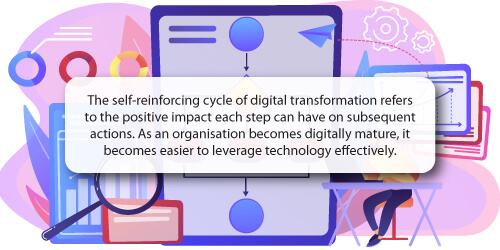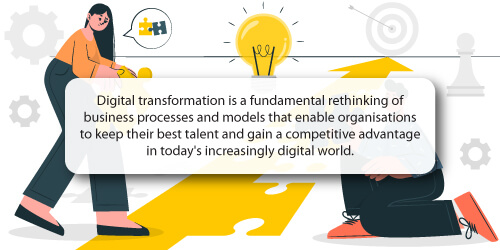The retail industry is undergoing a digital transformation, but it's a complicated process. The pace of change is accelerating, and those who resist will be left behind. It fundamentally changes how retailers operate and interact with their customers, suppliers, and other stakeholders to create new and more valuable business models.

This self-reinforcing cycle enables you to improve your ability to deliver a strong customer experience. In turn, it leads to more significant innovation and higher productivity levels. Finally, all these benefits allow you to generate greater efficiency across the entire value chain.

What is digital transformation in the retail industry?
Retail digital transformation is the process of using digital technology to transform the way an organisation operates.
Digital transformation is not a destination but rather a journey.

It involves looking at how you do business across your entire enterprise -from how you structure teams and make decisions to how you organise your customer experience or deliver products and services.
Digital transformation is not just about technology; it is about people, culture, processes, and business models. Transforming an organisation requires leaders to look at every area of their business to understand how they can leverage technology across their entire enterprise.

Digital transformation trends in retail eCommerce
In 2022, the most crucial trend in retail eCommerce has been the omnichannel experience.
Customers were no longer restricted to shopping via one channel but could buy a product or service across all relevant channels. For example, if a customer wanted to purchase a camera lens online, they could do so through their smartphone and then pay for it at the checkout counter inside their local camera store.
This trend is part of an overall movement towards personalisation in eCommerce. As consumers become more educated about their options and willing to try something new, brands have responded by providing personalisation options on websites or apps (such as recommendations based on past purchases).
It has led to greater engagement with these platforms among users who believe engaging with them is worthwhile because they offer value beyond simply browsing products without needing any upfront commitment. It ultimately improves brand loyalty and conversion rates.
The second most important trend was the seamless experiences across channels where people didn't have to switch from one place to another because they wanted some other kind of experience, like trying out product demos instead of reading reviews.
Here are a few other trends that we identified over 2022.
- Using Augmented Reality (AR) and Virtual Reality (VR) to create immersive experiences;
- Using Artificial Intelligence (AI) to personalise the shopping experience;
- Using blockchain technology to build trust in the supply chain, increase transparency, and reduce fraud or errors in transaction processing, inventory management, and logistics for last-mile delivery services; and
- Relying on micro-influencers whose followers were part of their target audience. It was in opposition to celebrities whose millions of followers weren't necessarily interested in what they sold/purchased through eCommerce channels.

Why digital transformation is crucial for the retail industry
The retail industry is undergoing a digital transformation that will significantly impact retailers' business. This transformation will benefit not only customers but also companies.

For retailers, it's crucial because it can help you adapt to changing market conditions and improve customer experience, thus increasing your sales and profit margins.
That means you must adapt your business models to better serve customers' needs in today's increasingly digital world. According to McKinsey's 2018 Global Retail Report, "only those who are prepared for change through digitalization at every level of their organization will be able to thrive".
So what trends should you and other retailers and brands adapt to future trends in eCommerce?
- Changing customer expectations;
- Changing technology; and
- Changing regulations.
As the landscape evolves and changes, so should your business practices. When it comes to digital transformation (DT) for eCommerce, you can no longer afford to wait until something is already outdated before making a move. Luckily, there are some simple ways to keep up with future trends.

How shoppers are adopting technology and online shopping
With the rise of digital transformation and online shopping, shoppers are adopting technology to research products, compare prices, buy online and access customer service.
They also use mobile apps and social media for quick information about products, brands, and competitors.
Shoppers are adopting new ways to interact with businesses – including messaging apps such as Facebook Messenger or WhatsApp – for customer service.
The pace of change is accelerating, and those who resist will be left behind. In 2022, a few key trends drove retail eCommerce digital transformation:
- Digitalisation;
- Data-driven;
- Personalisation;
- Mobile-focused; and
- Social.
By the end of 2022, the percentage of online sales will account for more than half of all retail eCommerce revenue. That means you must focus on building a successful online presence through your website and mobile app. More than that is the aspect of retail becoming data-driven.
It's worth pointing out that retail has always been data-driven. However, it's now about becoming more intelligent when managing your inventory through specialist category management software and pricing through predictive analytics software solutions.

Conclusion
As the retail industry adapts to new technologies, it will be necessary for retailers and brands alike to understand how these changes will affect their businesses.
Digital transformation is happening fast and accelerating, so if you don't keep up with these trends, you risk losing customers and sales.


